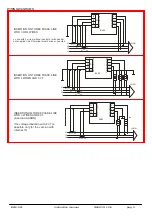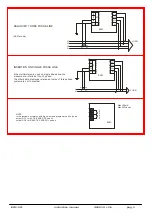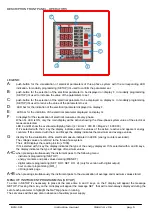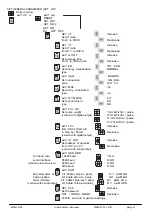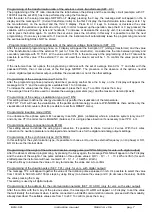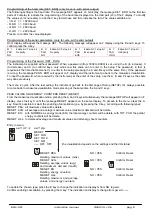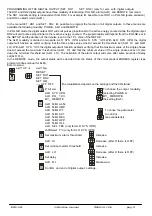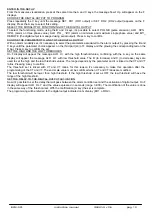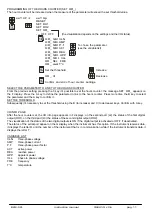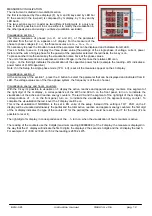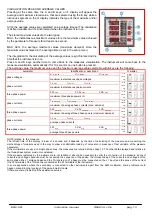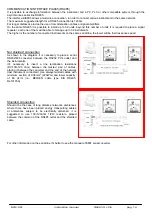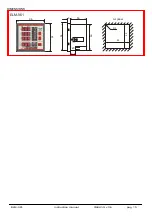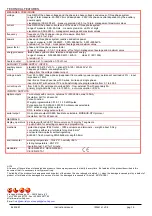
INSTALLATION
WARNING FOR THE USER
Read carefully the instructions/indications contained in this manual before installing and using the instrument.
The instrument described in this manual is intended for use by properly trained staff only.
SAFETY
This instrument has been manufactured and tested in compliance with EN 61010-1standards. In order to maintain these conditions and
to ensure safe operation, the person must comply with the indications and markings contained in the manual. When the instrument is
received, before beginning installation, check that it's O.K. And it has not suffered any damage during transport. When starting
installation make sure that the operating voltage and mains voltage are compatible with the device instructions. The instrument power
supply must not be earthed. Maintenance and/or repair must be carried out only by qualified and authorized personnel. If there is ever
the suspicious that, that there is a lack of safety ,during operation, the instrument must be disconnected and cautions taken against
accidental use.
Operation is no longer safe when: - The instrument doesn't work. / - The measured value are obviously wrong or
unreasonable / - There is clearly visible damage. / - After serious damage incurred during transport. / - After a storage under
unfavourable conditions
CONNECTION
For a correct use of the device, the wiring diagram contained in the present manual, must be respected.
The connections are available on the screw terminal:
- auxiliary power supply:
The power supply is take from voltage inputs.
Are available 3 different auxiliary supply:
0 - 115V = 100-130V 50-60Hz
(N-L3)
(on request)
0 - 230V = 220-240V 50-60Hz
(N-L3)
(on request)
0 - 400V = 380-415V 50-60Hz
(L2-L3)
(standard model)
It’s possible, for example, to give an auxiliary power supply between phase and neutral, in a 4 wires system, or phase-
phase in a 3 wires system, without neutral or from a VT in a medium voltage application.
In the standard version the voltage is 400V and it’s taken between the phases L2-L3.
In the following table it’s possible to see the measurable voltage depending of the type of power supply.
power supply terminals
rated voltage
range of measurable voltage
400V
300÷500V phase to phase (175÷290V phase-neutral)
230V
175÷290V phase to phase (130÷170V phase-neutral)
L2-L3 (phase to phase power supply)
110V
85÷145V phase to phase (50÷85V phase-neutral)
230V
300÷500V phase to phase (175÷290V phase-neutral)
L3-N (phase – neutral power supply)
110V
175÷290V phase to phase (100÷170V phase-neutral)
The standard version allows to apply the instrument at all the three-phase network 400V with or without neutral supplied.
ELM-961
instruction manual
IM441-U v0.6
pag. 2
For example for application on single phase 230V will need the L3-N / 230V. while for applications in medium voltage (for
example using external voltage transformer 15 / 0.1 kV phase to phase) will need the version L2-L3 / 110V.
- measure voltage inputs:
4 terminals are available for the connection to
the 3 phase and neutral of the network of
measure, the maximum voltage phase to
phase shouldn't be over 500 V rms and
dependent to the auxiliary power supply. In
case of a 3 phase system without neutral, or
non distributed neutral to leave terminal N
ELM-961
REAR PANNEL
free. It’s possible to use external voltage
transformer in fact the transformation rate of
the external transducer can be set in the
SETUP of the instrument and the
visualization allows the reading of voltage up
to 40,0 kV.
- measure current inputs:
4 terminals are available for the connection to
ENERGY COUNTERS
3 external amperometric transformers with secondary 5A, it’s possible to use 2 TA on lines with 3 wires (insertion three
phase Aron). The utilization of external TA is obligatory. The transformation rate of the external transducer can be set in
the SETUP of the instrument and the visualization allows the reading of voltage up to 9,99 kA.
REMARKS: It's a must to respect the phase sequence. The connections between current and voltage phase inputs must not be
inverted (for example, CT placed on phase L1 must correspond to the I1 input). So as it is not correct to invert S1 and S2 terminals,
since power factors and powers might not be reliable.
For fixing the flush mount version instrument to the panel, use the fixing devices supplied, by inserting them in the side groves of the
enclosure and tighten the screws.
For safety reasons, place an external fuse protection at the input voltages, and use adequate cables for the working voltages and
currents, with a cross sections from 0,5 to 2,5 mm
2
.



